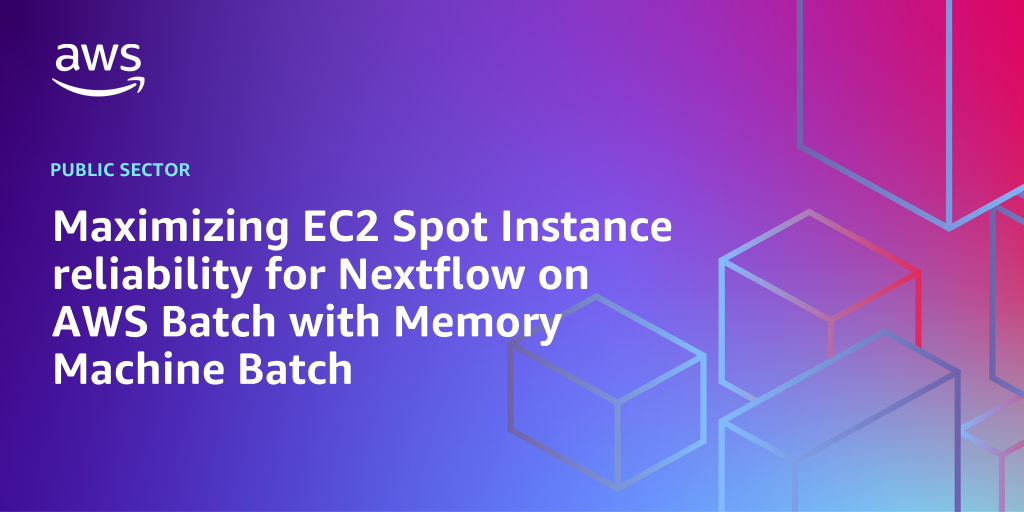AWS Public Sector Blog
Tag: AWS Batch
Maximizing EC2 Spot Instance reliability for Nextflow on AWS Batch with Memory Machine Batch
AWS partners with providers of innovative solutions such as MemVerge, an AWS Partner Network (APN) Advanced Technology Partner, whose Memory Machine Batch (MMBatch) technology complements AWS Batch by providing advanced checkpointing capabilities for EC2 Spot Instances. In this post, we look at how MemVerge’s technology can overcome the challenges of interrupted pipelines by enabling pipelines that were interrupted mid task to start from where they left off, regardless of Spot Instance reclaims. We’ll also show how MemVerge’s Batch Viewer and proven best practices empower researchers to visualize their workloads, identify bottlenecks, and apply smart strategies that make their pipelines more efficient, resilient, and cloud-optimized.
Harnessing cloud solutions to tackle water challenges
In this post, we explore how Amazon Web Services (AWS) cloud-based technologies can be used to address diversified and dynamic water challenges in Europe, the Middle East, and Africa. As climate change and demographic shifts continue to strain water resources, the need for innovative, technology-driven solutions has never been more urgent.
Alex’s Lemonade Stand Foundation uses AWS to advance cutting-edge pediatric cancer research worldwide
In 2017, the Alex’s Lemonade Stand Foundation (ALSF) founded the Childhood Cancer Data Lab (Data Lab) to address an important gap in the pediatric cancer field: vast amounts of accumulated data were not being put to use at scale. To address this gap, the Data Lab used AWS to build refine.bio, an openly available collection of normalized bulk gene expression data, to make public datasets interoperable and reusable.
Cleerly uses AI-driven heart imaging technology to help save lives with AWS
Cleerly is a digital health company innovating a new standard for coronary artery disease by going beyond the traditional methods of diagnosing heart disease. Using artificial intelligence and the AWS Cloud, Cleerly turns non-invasive, comprehensive quantification and characterization of atherosclerosis (plaque) building in arteries into actionable insights for clinicians before major heart attack symptoms emerge.
Driving innovation in single-cell analysis on AWS
Computational biology is undergoing a revolution. However, the analysis of single cells is a hard problem to solve. Standard statistical techniques used in genomic analysis fail to capture the complexity present in single-cell datasets. Open Problems in Single-Cell Analysis is a community-driven effort using AWS to drive the development of novel methods that leverage the power of single-cell data.
Accelerating genome assembly with AWS Graviton2
One of the biggest scientific achievements of the twenty-first century was the completion of the Human Genome Project and the publication of a draft human genome. The project took over 13 years to complete and remains one of the largest private-public international collaborations ever. Advances since in sequencing technologies, computational hardware, and novel algorithms reduced the time it takes to produce a human genome assembly to only a few days, at a fraction of the cost. This made using the human genome draft for precision and personalized medicine more achievable. In this blog, we demonstrate how to do a genome assembly in the cloud in a cost-efficient manner using ARM-based AWS Graviton2 instances.
UAE Mars mission uses AWS to advance scientific discoveries
On February 9, a new object successfully began to orbit Mars: an uncrewed spacecraft called the Hope Probe. The mission has already returned the first image of Mars, taken by Hope’s Emirates eXploration Imager from an altitude of 24,700 km. Led by the Mohammed Bin Rashid Space Centre (MBRSC), the Hope Probe is the first interplanetary mission for the United Arab Emirates, the fifth country in history to reach the red planet. It will also be the first spacecraft to capture a complete picture of the Martian atmosphere and its layers during different times of the day and different seasons for one complete Martian year. Once data transmitted by the Hope Probe reaches the scientific teams on Earth, MBRSC will use AWS advanced technologies to process and analyze the vast amounts of data and imagery to help researchers better understand the Martian atmosphere and its layers.
An introduction to AWS for research IT: Getting started in the cloud
The cloud can help researchers process complex workloads, store and analyze enormous amounts of data, collaborate globally, and accelerate research and innovation. For research IT, Amazon Web Services (AWS) can help build scalable, cost-effective, and flexible environments while still maintaining the governance and guardrails for security and compliance. Following best practices, AWS allows for centralized management of resources, improved security and compliance of research workloads, and can save costs and accelerate innovation. What are some common questions from research IT customers?
California uses open source solutions and the cloud to create a model of models
Governments, like the state government of California, are in the midst of a transition to a new way of delivering vital information, services and programs using technology and the cloud. Government organizations are adopting approaches pioneered in the technology industry, including user-centered design, agile development, data science, modular contracting, and the use of modern technology platforms. Many of these governments, like the state of California, are using Amazon Web Services (AWS) to respond quickly and scale to battle unprecedented challenges, like COVID-19, and help them quickly make decisions about how to protect their constituents.
Capella and SpaceNet deliver unique views of Earth with machine learning on AWS
The breadth of challenges that can be addressed by overhead imagery is broad and continues to grow as new and improved sensors are deployed. To make the best use of this data, you need to have high-quality training data—data that you know is true (often called ground truth data) so that your algorithms can learn from it. A lack of this high-quality labeled training data continues to impede progress in many areas of remote sensing analytics, including machine learning. Two of the SpaceNet collaborators, Capella Space and AWS, are providing access to a unique dataset to help foster innovation in geospatial-based artificial intelligence. Learn more about Earth observation data, the SpaceNet 6 Challenge, and available datasets.









